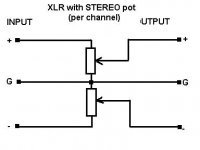to my understanding, a balanced line has 2 signals, exactly the same but out of phase by 180deg, so that any common interference is regected by the amp
cartman, if that doesn't work im sure a stereo pot (dual pot) on the hot and cold lines should work.
cartman, if that doesn't work im sure a stereo pot (dual pot) on the hot and cold lines should work.
Dan2 said:
cartman, if that doesn't work im sure a stereo pot (dual pot) on the hot and cold lines should work.
Do you mean this? (attachment)
...by the way, this is not logical/likeable for me, because in this case I loose the "Ground independence" 🙁
What do you think?
Attachments
Hi Cartman,
A variation of your first drawing is the inclusion of two identical precision resistors in the signal wires and then a variable resistor between their ends, no reference to ground. It is used, I think, by Morgan Jones and Erno Boberly.
However, according to D. Self who designed mixers, your second design is to be the prefered one (the pots are supposed well matched) because it has a better common mode rejection. Common mode voltages are not rejected by the first solution.
A variation of your first drawing is the inclusion of two identical precision resistors in the signal wires and then a variable resistor between their ends, no reference to ground. It is used, I think, by Morgan Jones and Erno Boberly.
However, according to D. Self who designed mixers, your second design is to be the prefered one (the pots are supposed well matched) because it has a better common mode rejection. Common mode voltages are not rejected by the first solution.
Thanks Forr for you reply...
by the way, I would like to build a passive balanced preamp with my just stereo (dual) stepped ladder 10K attenuator.... 😕
What is the best solution?
Which benefit is the more important?
1) "no reference to ground"
2) "Common Mode Voltage Rejection"
As I know, the balanced signal is great why there is independence of ground. Is it true?
by the way, I would like to build a passive balanced preamp with my just stereo (dual) stepped ladder 10K attenuator.... 😕
What is the best solution?
Which benefit is the more important?
1) "no reference to ground"
2) "Common Mode Voltage Rejection"
As I know, the balanced signal is great why there is independence of ground. Is it true?
as far as i know, common mode signals (interference) are usually a problem with very long wires, so if you put the attenuator pretty close to the amp (mixer) it should be ok.
i have never put an attenuator on a balanced line so i can't really help too much more
i have never put an attenuator on a balanced line so i can't really help too much more
cartman said:
by the way, I would like to build a passive balanced preamp
with my just stereo (dual) stepped ladder 10K attenuator.... 😕
Hi,
That is not possible without input and ouput transformers.
🙂/sreten.
Dan2 said:...
i have never put an attenuator on a balanced line so i can't really help too much more
Thanks Dan2!
sreten said:
Hi,
That is not possible without input and ouput transformers.
🙂/sreten.
Thanks Sreten!
...and if I would have 2pcs stepped ladder 10K attenuators? (1 dual per each channel) can I use it? (w/o transformer)
If so, how I can connect?
thx!
cartman said:
Thanks Sreten!
...and if I would have 2pcs stepped ladder 10K attenuators?
(1 dual per each channel) can I use it? (w/o transformer).
If so, how I can connect ?
thx!
Hi,
I'd of thought this was obvious. You connect the dual attenuators
across hot and cold to a floating point which is not connected to
anything. Hot / cold in go to hot / cold out via the attenuators.
Ground in to ground out is a direct connection.
Balanced performance is only as good as the resistor matching.
🙂/sreten.
Consider one channel only.
Connect the attenuator across hot/cold.
But you NEED a line resistor in BOTH the hot and the cold. Most attenuators do not provide this.
Next the line resistors must be accurately matched. At worst +-0.1% but aim for 0.01% matching.
Then double it up for dual channel. Matching between channels needs +-1%.
Connect the attenuator across hot/cold.
But you NEED a line resistor in BOTH the hot and the cold. Most attenuators do not provide this.
Next the line resistors must be accurately matched. At worst +-0.1% but aim for 0.01% matching.
Then double it up for dual channel. Matching between channels needs +-1%.
- Status
- Not open for further replies.
- Home
- Source & Line
- Analog Line Level
- Looking for Balanced attenuator ideas

